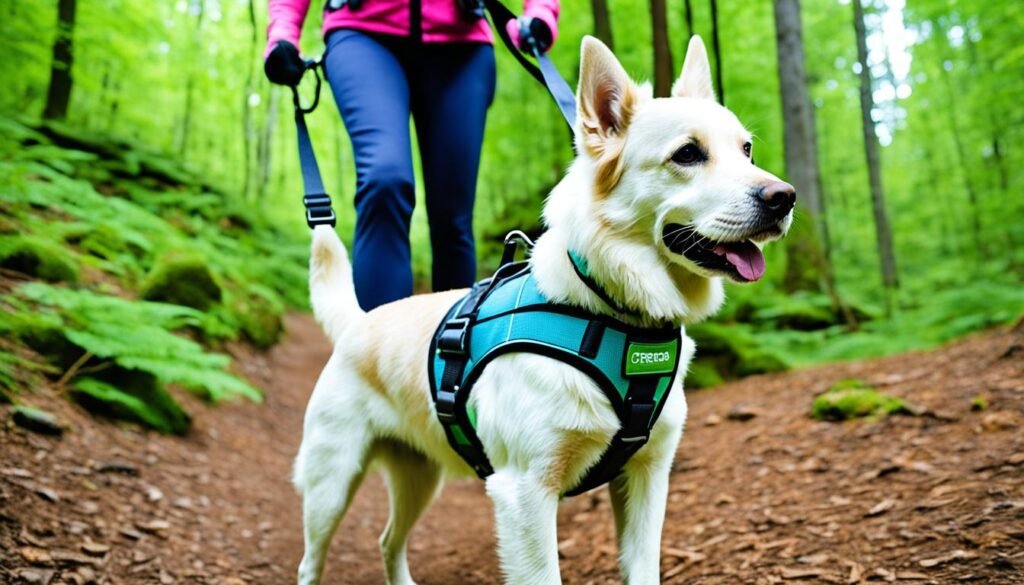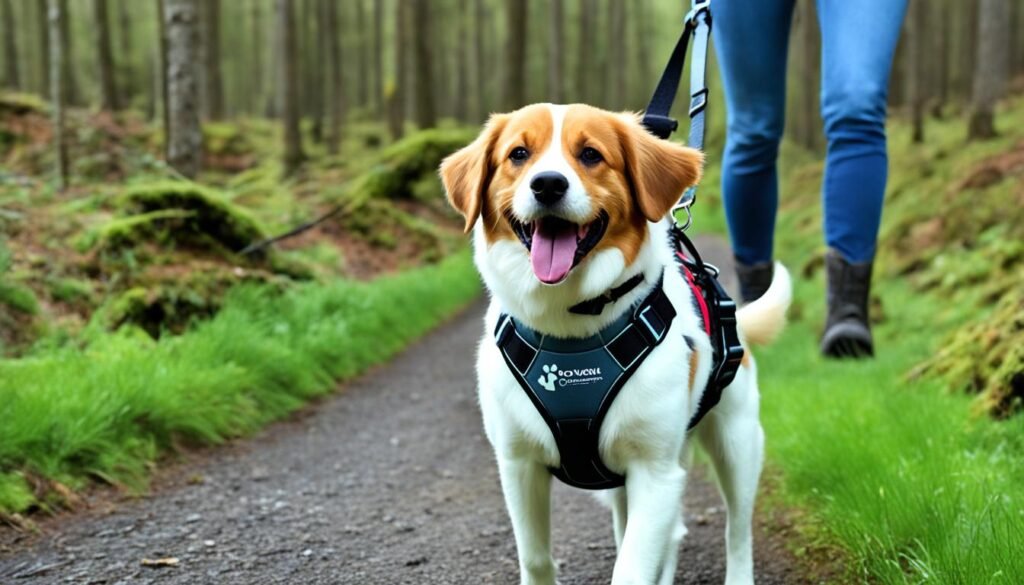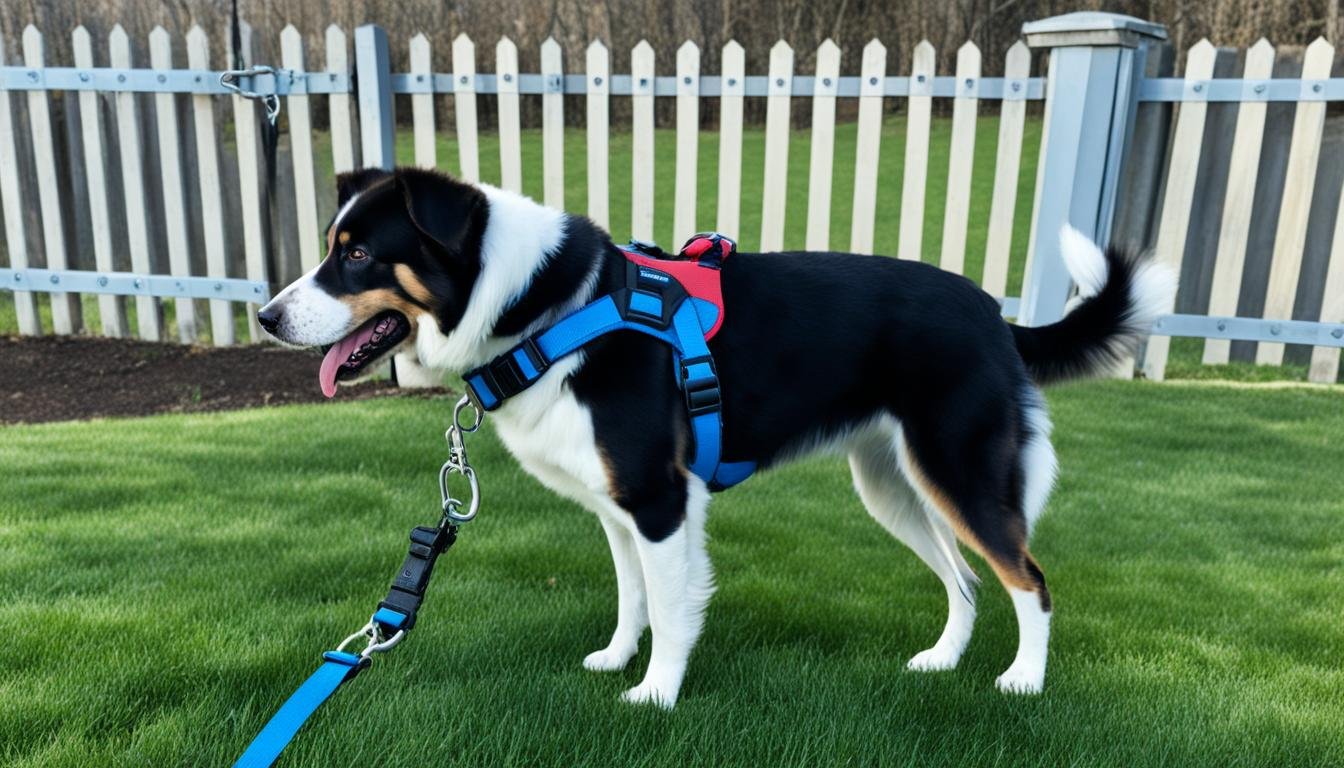Choosing the right gear for walking your dog can be tough. Should you pick a leash or a harness? Each has its own perks, but which is best for your dog? This article will look at the main differences between these two popular dog accessories. It aims to help you pick the right one for your dog’s comfort and safety.
Ever thought about whether a leash or a harness is better for your dog? This question is key to our discussion. We’ll dive into the unique benefits and things to consider for each option.
Key Takeaways
- Understand the fundamental differences between dog collars and harnesses
- Explore the advantages of using a dog leash, including convenience and control
- Discover the comfort and safety benefits of dog harnesses
- Learn how to choose the right option based on your dog’s needs and training goals
- Gain insights into breed-specific recommendations for leashes and harnesses
Introduction: Understanding the Differences
Choosing the right dog collar is key for our furry friends. From the classic flat collar to the innovative martingale collar, there are many options. We’re here to guide you in picking the best one for your dog.
Dog Collars: A Widely Available Option
The standard flat collar is one of the most common choices. It comes in many colors, materials, and designs. But, there are other collars like the martingale (Amazon Affiliate link) and rolled collars that offer special benefits for different dogs.
Martingale collars are perfect for dogs with necks similar in size to their heads. They prevent slipping out of collars. Rolled collars are good for dogs with sensitive skin or wrinkles but not for those who pull a lot.
- Flat collars: A classic and widely available option
- Martingale collars: Ideal for dogs with similar neck and head sizes
- Rolled collars: Comfortable for dogs with sensitive skin or wrinkles
It’s crucial to pick the right collar size for your dog’s comfort and safety. With many options, research well to find the best fit for your furry friend.
Advantages of Dog Collars
Dog collars are a great choice for walking your furry friend. They give you better control and need less strength than harnesses, especially for smaller dogs. This is super helpful for owners who have trouble with their strength or mobility.
For puppies learning leash walking, a standard dog collar is usually the best pick. There are many styles and materials to choose from, making them easy to put on and take off. This ensures a comfy fit for your little pup.
- Collars offer better control and require less physical strength during walks, depending on your dog’s size.
- Collars are the preferred choice for puppy training and leash walking.
- The diverse range of collar styles and materials ensures comfort and ease of use for your dog.
“A well-fitted collar can make walking your dog a breeze, while also providing the necessary control and comfort for both of you.”
Looking for something simple or stylish? Dog collars are versatile and practical for your dog’s needs. They’re known for their collar comfort and ease of use, making them a top choice for many dog owners.
dog leash vs harness
Are you thinking about switching from a traditional dog collar to a more comfy dog harness? Harnesses have many benefits over leashes, making them a top pick for many pet owners.
Exploring Dog Harness Options
There are many types of dog harnesses, each suited for different needs and likes. A standard body harness with a back clip is a top choice for smaller dogs. Front-clip harnesses and no-pull harnesses help stop pulling. For big dogs that pull a lot, a head halter harness can help you control them better.

“A well-fitted harness can make walks more enjoyable for both you and your dog, as it distributes the pressure evenly across the chest and shoulders, reducing strain on the neck.”
When picking a dog harness, think about your dog’s size, breed, and needs. It’s key to get the right fit for your dog’s comfort and safety.
- Standard body harnesses with back attachment points are great for small to medium-sized dogs.
- Front-clip harnesses and no-pull harnesses can help stop pulling.
- Head halter harnesses are good for big dogs that pull a lot on the leash.
Choosing the right dog harness can really change how you walk your furry friend.
Advantages of Dog Harnesses
Choosing between a leash and a harness for our dogs can be tough. Dog harnesses have many benefits that make them a top choice for many. Let’s look at some key reasons why using a harness with your dog is a good idea.
A dog harness is great for comfort and safety, especially for small or sensitive dogs. It spreads the weight and pressure across the chest and shoulders, not the neck. This is good for dogs with breathing problems or those who pull hard on the leash.
Also, a good harness for pulling stops your dog from pulling too much. It helps your dog walk in a natural way, stopping them from straining their neck or back. This makes walks better for you and your dog and helps prevent health issues later.

For dogs with sensitive skin or fur, a harness is kinder than a collar. It spreads out the pressure, so it doesn’t irritate or chafe. This is great for dogs with thin skin or thick fur, making walks more comfortable and stress-free.
“A properly fitted harness can make a world of difference in the well-being and enjoyment of our canine companions.”
Putting on and taking off a harness might take more effort than a collar. But the benefits are worth it. By thinking about the harness benefits for your dog, you can choose what’s best for their comfort, safety, and happiness on walks and adventures.
Choosing the Right Option for Your Dog
Choosing between a collar or a harness for leash training can greatly affect your pup. It’s wise to start with a harness and switch to a collar later. Puppies pull hard when learning to walk on a leash. A collar can put pressure on their neck, which might harm them.
Considerations for Puppy Training
Puppies are still learning how to move and are not strong yet. A harness is safer and more comfy for their puppy training with collar vs harness. It spreads out the pulling force on their chest and shoulders, not their neck. This helps you teach them to walk nicely without hurting them.
Breed-Specific Recommendations
Some dog breeds are better off with a harness, not just as puppies. Small toy breeds, dogs with neck problems, brachycephalic breeds (like pugs and French bulldogs), and those with back issues prefer a harness for specific dog breeds. Your vet can tell you the best choice for your dog.
“The choice between a collar and a harness can make a big difference in your dog’s comfort and safety during leash training.”
Deciding between a collar or a harness depends on your dog’s needs, breed, and your vet’s advice. With the right advice, leash training can be positive and rewarding for your pup.
Conclusion
Choosing between a dog collar or harness is a big decision. It depends on your dog’s needs. Collars are versatile, while harnesses offer more comfort and control.
The best choice depends on your dog’s size, health, and activities. Talking to your vet can help you decide. This way, you keep your pet safe and happy.
Whether you pick a collar or a harness, make sure your dog is comfortable and secure. With the right dog walking gear, you and your dog can have fun and safe times choosing collar or harness that fits their needs.
Read more about dog harnesses here.
FAQ
What are the main differences between dog collars and dog harnesses?
Dog collars and harnesses are not the same. Collars help control your dog with less effort. Harnesses are more comfy for dogs, stop pulling, and prevent injuries. The right choice depends on your dog’s size, health, and behavior.
What are the different types of dog collars?
There are many dog collars like flat, martingale, and rolled ones. Each type suits different dogs and situations.
What are the benefits of using a dog collar?
Dog collars make walking easier, especially for new puppies. They come in various styles and materials. They’re easy to use, comfy for your dog, and last a long time.
What are the different types of dog harnesses?
There are many dog harnesses, like standard, front-clip, no-pull, and head halter ones. Each has its own benefits for different dogs and situations.
What are the benefits of using a dog harness?
Harnesses are comfy for dogs and stop pulling. They prevent injuries like throat or back damage. They’re great for small dogs, dogs with neck issues, and those prone to back problems.
When should I start using a harness with my puppy?
Start with a harness for your puppy’s leash training. Collars can be harmful if a puppy pulls hard, causing throat damage. A harness is safer.
Are there certain dog breeds that are better suited for harnesses?
Yes, some breeds like small toy dogs, those with neck issues, brachycephalic breeds, and back-prone dogs do well with harnesses. Your vet can advise on the best gear for your dog.


